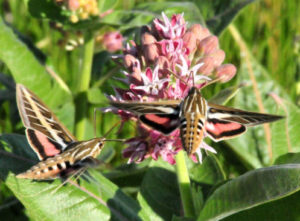
Hummingbird moth on milkweed (and there are many different varieties of milkweed to choose from when planting!) Photo by T. Koerner and courtesy of USFWS.
As I’ve mentioned before, some of the biggest issues facing moths are habitat loss and becoming the unintended target of biocontrol efforts- while we may only be able to influence the latter policy-wise, we have a lot of options when looking at moth habitat and population concerns.
When I started looking for groups that work on moth conservation, I found a huge number of local and regional options- I’m not listing them all here, but, if your area isn’t covered, it might be worth a quick internet search to find something close to you.
If you’d prefer to help moths from a distance, you can donate to the Xerces Society which works for moth and butterfly conservation in North America. Many of the other groups listed below also would appreciate more funding for their projects.
Looking to make your home or region more moth-friendly?
Want to spend some time getting up close and personal with moths?
There are many small groups working to support moth populations- since one of the big issues is habitat loss, creating a moth-friendly backyard can make a difference, but we also need to work at larger scales to preserve habitat so that moth populations don’t become isolated in their own tiny pockets of habitat- so, if you don’t find your area represented by the organizations above, check with community-based conservation groups near you- by expanding the breadth of habitat protection and restoration, we can give moths a fighting chance in the long-term.
In my last post I mentioned that two of the biggest challenges facing native moth populations are unintended targeting by biological control species and habitat fragmentation. With regard to biological control, the remedy is to be as selective with insect-specific controls as we are with other species, and that’s something to be addressed at a policy-level. The issue of habitat conversion and fragmentation can be addressed at a much smaller level, sometimes even in your own backyard. There’s a lot of recent research looking at the habitat elements that make a place good for moths, and we can use that information to create management strategies that help us utilize the resources we need while also giving moths a place in the equation.
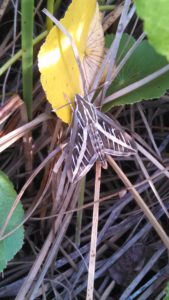
I found this moth while doing field work about 100 m from the Gulf of Mexico- not exactly who I thought would be hanging out in the marsh grass!
It’s about structure, structure, structure. And by that I mean both the community of plant species in a location and the way that those plants fill the vertical space. Moth research from Finland suggested that the quality of habitat for larvae was more important for species persistence in a location than the ability of adult moths to actually get to the location (Várkonyi et al. 2003). For many species of moth, that means having the right plants available at the right time. Researchers monitoring moth communities in southern Bohemia believed that the reason moth diversity had remained pretty stable over 25 years was that the local plant community provided a number of specific, diverse microhabitats (Spitzer and Jaroš 2009). A changing climate may create issues there, since some moth species seem to be reproducing later in the summer even as plants are shifting to an earlier schedule (Liu et al. 2011). And for other species in managed forests, the harvesting program can be important– sometimes selective logging removes specific plant species from the landscape, leaving specialist moths high and dry (Summerville and Crist 2002). As it turns out, logging is about more than just removing trees when it comes to moths- trees sometimes change leaf chemistry in response to disturbance and a researcher in Indiana found that trees as far away as 200m from logged sites were impacted (Summerville 2011). Changing leaf chemistry can mean lower quality food for moths. Fortunately, there are things we can do to give moths both the types and shapes of the plants they need– Summerville (2013) found that removing ~15% of the timber helped butterfly and moth communities recover faster when compared to group and clear-cut logging. And researchers in Finland recommended having cattle graze some unused pastures to help maintain a mix of species and plant sizes (Poyry et al. 2005).
And connecting the dots is a good thing, too. Research in the UK found that moths which specialize in forest habitats moved smaller distances in general (Slade et al. 2013)- as forest fragments get farther and farther apart, these moths will be less likely to move between locations, which means that, if a population disappears in one spot, it is less likely to reestablish later. As Ricketts et al. (2002) commented, landscape mosaics are important because they provide a variety of habitats, and, if the patches if similar habitat aren’t too far away, moths can move more easily between them. Hedgerows and additional tall vegetation around single trees can help provide corridors and stepping stones for moths to disperse along. Corridors are also helpful in other types of habitats- an assessment of agri-environment strategies in the UK found that moth populations in agricultural landscapes were particularly helped by leaving strips of natural or semi-natural vegetation along waterways and field margins (Fuentes-Montemayor et al. 2011).
All of this research really connects back to the fact that moth species use a variety of habitats and differing combinations of plants within those habitats, so protecting moth populations means protecting a variety of plant species and a means to get between those plants. What can we do to support them, even if we don’t have a backyard moths can use as habitat? In my final post of the moth, I’ll look into ways for everyone to get involved in moth conservation.
Works cited:
Fuentes-Montemayor, E., D. Goulson, and K.J. Park. 2011. The effectiveness of agri-environment schemes for the conservation of farmland moths: assessing the importance of a landscape-scale management approach. Journal of Applied Ecology 48:532–542.
Liu, Y., P.B. Reich, G. Li, and S. Sun. 2011. Shifting phenology and abundance under experimental warming alters trophic relationships and plant reproductive capacity. Ecology 92:1201–1207.
Poyry, J., S. Lindgren, J. Salminen, and M. Kuussaari. 2005. Responses of butterfly and moth species to restored grazing in semi-natural grasslands. Biological Conservation 122:465–478.
Ricketts, T.H., G.C. Daily, and P.R. Ehrlich. 2002. Does butterfly diversity predict moth diversity? Testing a popular indicator taxon at local scales. Biological Conservation 103:361–370.
Slade, E.M., T. Merckx, T. Riutta, D.P. Bebber, D. Redhead, P. Riordan, and D.W. Macdonald. 2013. Life-history traits and landscape characteristics predict macro-moth responses to forest fragmentation. Ecology 94:1519–1530.
Spitzer, K., and J. Jaroš. 2009. Long-term monitoring of moth populations (Lepidoptera) associated with a natural wetland forest: synthesis after 25 years. Terrestrial Arthropod Reviews 1:155–163.
Summerville, K.S. 2011. Managing the forest for more than the trees: effects of experimental timber harvest on forest Lepidoptera. Ecological Applications 21:806–816.
Summerville, K.S. 2013. Forest lepidopteran communities are more resilient to shelterwood harvests compared to more intensive logging regimes. Ecological Applications 23:1101–1112.
Summerville, K.S., and T.O. Crist. 2002. Effects of Timber Harvest on Forest Lepidoptera: Community, Guild, and Species Responses. Ecological Applications 12:820–835.
Várkonyi, G., M. Kuussaari, and H. Lappalainen. 2003. Use of Forest Corridors by Boreal Xestia Moths. Oecologia 137:466–474.
In looking at moth conservation research over the last week, it quickly became clear that we have something of a love-hate relationship with these insects, a relationship that is heavily influenced by whether or not a species is native. As might be expected, native species are often in trouble and non-natives often cause trouble for us. And sometimes it’s our reaction to the invasive species that has caused problems for native moths.
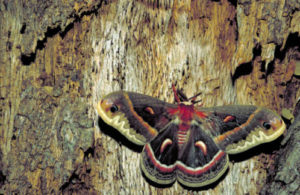
This cecropia moth is unintended prey for C. concinnata– photo by TG Barnes and courtesy of USFWS
When we look at the invasive side of the coin, we only have to look at the gypsy moth, the browntail moth, and the cactus moth to find species that have radically changed the environments they are in, and sometimes that change was our goal. Cactus moths are native to South America but were introduced in a number of locations, including Australia, as a biological control for invasive cacti species (Zimmermann et al. 2001). That biological control worked pretty well, but now the species has arrived in North America and could threaten our native cacti such as prickly pears. We also have a history of using biological controls against invasive moths, and the results aren’t always what we intended. We released a moth parasite, the fly Compsilura concinnata, to control gypsy moth populations in the US starting in 1906 (Elkinton et al. 2006). While the fly does prey on gypsy and browntail moths, it also has attacked at least 180 native species, and research published in 2000 suggested that at least two species of native silk moth have been severely impacted by the fly (Boettner et al. 2000).
Unfortunately the challenges facing native moths go beyond unexpected impacts of biological control. By 2006 the UK had seen sharp declines in more than half of 337 common moth species surveyed (Conrad et al. 2006)- since the researchers did not have enough data to complete the same analyses for rare moth species, their results probably underestimated the actual declines in British moths. Nieminen (1996) suggested that moths differ in their risk of extinction based, in part, on what they eat- moths that eat perennials are less at risk than moths that eat annuals. Why are perennials less risky? These food sources are more stable year to year, whereas annuals may be present one summer and then gone the next. When you add the effects of habitat conversion and fragmentation, a population of annual-eating moths may lose all local food sources in a short amount of time. Of course, perennials may take longer to establish and grow large enough to support moths, and so perennial-eating moths could be at risk if habitat disturbance is big enough.
Why should we care about declining moth populations? It turns out that there are many more moths than butterflies (Ricketts et al. 2002), and these insects are important as pollinators, herbivores, and food for other animals (Summerville and Crist 2004). Because they are nocturnal and inhabit forests as well as meadows (Ricketts et al. 2002), hummingbirds and butterflies can’t just step into their shoes as pollinators or as food for migrating passerine birds- if we lose the moths, we lose important ecological relationships.
Fortunately, we are constantly developing a better understanding of what moths need to survive- in my next post I’ll look what we know about supporting moth populations.
Works cited:
Boettner, G.H., J.S. Elkinton, and C.J. Boettner. 2000. Effects of a Biological Control Introduction on Three Nontarget Native Species of Saturniid Moths. Conservation Biology 14:1798–1806.
Conrad, K.F., M.S. Warren, R. Fox, M.S. Parsons, and I.P. Woiwod. 2006. Rapid declines of common, widespread British moths provide evidence of an insect biodiversity crisis. Biological Conservation 132:279–291.
Elkinton, J.S., D. Parry, and G.H. Boettner. 2006. Implicating an Introduced Generalist Parasitoid in the Invasive Browntail Moth’s Enigmatic Demise. Ecology 87:2664–2672.
Nieminen, M. 1996. Risk of Population Extinction in Moths: Effect of Host Plant Characteristics. Oikos 76:475–484.
Ricketts, T.H., G.C. Daily, and P.R. Ehrlich. 2002. Does butterfly diversity predict moth diversity? Testing a popular indicator taxon at local scales. Biological Conservation 103:361–370.
Summerville, K.S., and T.O. Crist. 2004. Contrasting Effects of Habitat Quantity and Quality on Moth Communities in Fragmented Landscapes. Ecography 27:3–12.
Zimmermann, H.G., V.C. Moran, and J.H. Hoffmann. 2001. The renowned cactus moth, Cactoblastic cactorum (Lepidoptera: Pyralidae): its natural history and threat to native opuntia floras in Mexico and the United State of America. The Florida Entomologist 84:543–551.
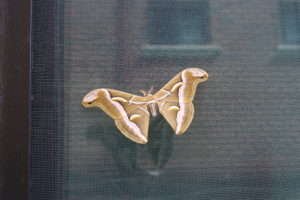
I found this moth while wandering around an urban environment- not exactly the wildlife I was expecting to see!
I tend to have ambivalent feelings about insects- love the dung beetles, not so much the termites. I’m also a creature of the day- sun’s up and I’m ready to go, sun’s down and I’m ready for bed. As a result, while I spend a good chunk of time paying attention to the butterflies I see, I’m not nearly as aware of the moths. As luck would have it, now is a perfect time for me to try correcting that ignorance- not only are the nights warm and welcoming, but July celebrates National Moth Week (the 23rd through the 31st), a now-global operation whose goal is to help people become more aware of and citizen scientists for moth conservation. Check out their website for information on events near you and ways to submit moth sightings!
In the meantime, I’ll be looking into the state of moth populations and moth conservation around the world. My knowledge about moths is pretty basic- apart from generally recognizing them as nighttime counterparts of butterflies, which means that they probably face many of the same pesticide and habitat loss issues, I’m really not sure if their populations are doing well or if they have special challenges. The learning curve is bound to be pretty steep here, and I’ll pass along what I find. Hopefully you’ll do the same with any moths you encounter!
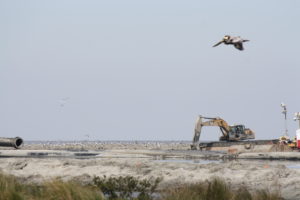
An artificial berm was created on the bay-side of this island and then new substrate was piped in to add sediment- in time plants such as mangroves will colonize the new soil and a marsh will develop.
We know that wetlands around the world face big challenges: fragmentation, pollution, conversion, climate change, etc. But we also know that there are ways to combat these issues, and some of those options give us the chance to get directly involved in wetlands conservation. If you are looking for a way to participate, you’ve got lots of choices-
For learning more about wetlands conservation in general and small actions that can make a difference in the long-term:
If you want to contribute to organizations that work at an international level:
- RAMSAR brings together information on a country-by-country basis and seeks to list and protect wetlands of international importance- they also coordinate World Wetlands Day
- Birdlife is involved in conservation efforts that benefit wetland-using birds
- Wetlands International needs volunteers for a variety of projects, including their annual waterbirds count
- you can adopt a pink river dolphin from World Wildlife Fund
- Ducks Unlimited has helped protect over 4 million hectares of wetlands in the Americas- even if you aren’t a hunter, please consider buying a duck stamp– it is estimated that declining numbers of hunters between 1995 and 2008 resulted in $126 million less in duck stamp revenues (Vrtiska et al. 2013), money that would have been used to help protect vital wildlife habitat
For national and regional groups, you have a lot of choices (I’m just providing a small selection- the US EPA even maintains a directory of volunteer monitoring projects for water quality)- you can donate, visit their centers, or volunteer to help with projects:
Given the wide ranging issues facing wetlands around the world, it’s nice to know that we also have a wide range of ways to get involved in protecting these important habitats. Hopefully you find something that sparks your interest- if not, this may be your opportunity to start something new!
Works cited:
Vrtiska, M.P., J.H. Gammonley, L.W. Naylor, and A.H. Raedeke. 2013. Economic and conservation ramifications from the decline of waterfowl hunters. Wildlife Society Bulletin 37:380–388.
As I have mentioned in previous posts, wetlands around the world are disappearing, in part because of land use changes and climate change. We should all be concerned about these losses because wetlands provide a number of ecosystem services that benefit us all, services like water filtration, vital wildlife habitat, carbon sequestration (in the peat), and flood mitigation. Are there ways to slow and even reverse these losses? Yes, and although we have yet to figure out all of the pieces of the puzzle, we’ve got some good ideas about what does (and does not) work.
Quite a bit of research has been done to help prioritize conservation efforts by indicating which wetlands are at greatest risk. The threat to a wetland increases with proximity to development and roads, and that risk is intensified by the size of the development or roadway (Gutzwiller and Flather 2011), which makes sense because that means that more people are using the area. Unfortunately, a 2011 study (Wardrop et al. 2011) in the Appalachians found that areas with the highest rates of population growth were not generally places with wetland conservation efforts, so those wetlands most likely to be suggested for development were also less likely to have people watching out for them. In flatter areas of the planet, we know that prairie wetlands are at greater risk as farming continues to change from smaller, more diverse farms to larger, more intensive agriculture (Doherty et al. 2013), and Bartzen et al. (2010) suggested prioritizing conservation of those pristine wetlands which still exist because, once impacted, they were not expected to fully recover.
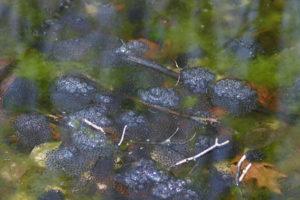
These wood frog eggs were laid in an ephemeral pool because ponds with year-round water provide habitat to bull frogs and other animals that will eat frog eggs. Photo courtesy of Connecticutbirder- license
What if we have already lost the wetlands we need? There are some options for created wetlands, but we need to really pay attention to the details. One thing we need to ask ourselves is exactly what we want a created wetland to do– are we interested in wildlife habitat or nutrient storage? Do we want flood control or carbon sequestration? A study of wastewater wetlands (yes, that means creating wetlands at wastewater treatment plants- and they are nothing to sneeze at- there’s even one in Australia that is listed with the Ramsar Convention!) indicated that large, shallow ponds which benefit birds and invertebrates are good for nitrogen storage, but not phosphorus storage (Murray and Hamilton 2010). We can just dig out an area and divert a water source into it and a wetland of sorts will develop over time, but there’s a bit more to the science than simply saturating the ground. A long-term study in Ohio which compared the plant diversity of created wetlands over 15 years found that, when left to their own devices, wetland plants will colonize the area, but the overall plant diversity is higher with targeted plantings of specific species (Mitsch et al. 2012). And getting the hydrology right is hugely important– created wetlands in Kentucky were originally designed to have water year-round, which is great for animals like bullfrogs (Denton and Richter 2013). Wetlands that don’t dry out for at least part of the year are no good, however, for animals like marbled salamanders which breed in ephemeral pools too short-lived for larger predatory amphibians- they need ponds that disappear so that their eggs and young have a safe place to develop.
So the first goal is to protect the wetlands we have, and the second is to create the additional wetlands we need by considering all of the things that wetlands do and then trying to recreate those conditions. How can we personally get involved with that? That’s what I’ll look into for my final post of the month.
Works cited:
Bartzen, B.A., K.W. Dufour, R.G. Clark, and F.D. Caswell. 2010. Trends in agricultural impact and recovery of wetlands in prairie Canada. Ecological Applications 20:525–538.
Denton, R.D., and S.C. Richter. 2013. Amphibian communities in natural and constructed ridge top wetlands with implications for wetland construction. The Journal of Wildlife Management 77:886–896.
Doherty, K.E., A.J. Ryba, C.L. Stemler, N.D. Niemuth, and W.A. Meeks. 2013. Conservation Planning in an Era of Change: State of the U.S. Prairie Pothole Region. Wildlife Society Bulletin 37:546–563.
Gutzwiller, K.J., and C.H. Flather. 2011. Wetland features and landscape context predict the risk of wetland habitat loss. Ecological Applications 21:968–982.
Mitsch, W.J., L. Zhang, K.C. Stefanik, A.M. Nahlik, C.J. Anderson, B. Bernal, M. Hernandez, and K. Song. 2012. Creating Wetlands: Primary Succession, Water Quality Changes, and Self-Design over 15 Years. BioScience 62:237–250.
Murray, C.G., and A.J. Hamilton. 2010. Perspectives on wastewater treatment wetlands and waterbird conservation. Journal of Applied Ecology 47:976–985.
Wardrop, D.H., A.K. Glasmeier, J. Peterson-Smith, D. Eckles, H. Ingram, and R.P. Brooks. 2011. Wetland ecosystem services and coupled socioeconomic benefits through conservation practices in the Appalachian Region. Ecological Applications 21:S93–S115.
I started looking into research on wetland loss around the world and quickly discovered that a large portion of what’s been published is about the Gulf Coast, specifically Louisiana. I could write for days about the situation all around me, but I know that wetlands in many locations are in trouble, so I kept digging for studies outside of the Gulf of Mexico. The bad news is that I found many other areas with wetland loss, so the good news (if you can call it that) is that I can give you a global overview of the issues facing wetlands.
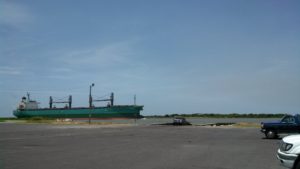
The Calcasieu Ship Channel is important for trade but also allows salt water to more easily get to freshwater marshes, especially during storms, which can be a problem for the flora and fauna.
One thing to remember as we go through this is that wetlands are really dynamic systems– since water is constantly cycling through, conditions rarely stay exactly the same for long. Water flowing in can bring sediment or dissolved minerals or pollution; water flowing out can do the same thing. Water can move sediment and vegetation within the system. Add to that storm events, human disturbance, invasive species, etc. and you have a recipe for a habitat which is constantly changing. Some spots fill in, others open up; some get taller, some sink down; plant and animal communities change. If there is one thing I have truly internalized during my car and boat rides to my study sites in coastal Louisiana, it’s to expect that the route will change at some point. This constant change becomes an issue for wetland conservation because it doesn’t fit into our plans: we like to base our plans on the idea that what we see today is what we will see tomorrow, and that’s not always the case with wetlands, especially in the long-term (Larson et al. 1980).
Of course, wetland conservation wouldn’t be a big concern if we weren’t losing wetland habitat on a grand scale around the world. What are the main issues facing wetlands? The larger trends are conversion to other land types, fragmentation, changes in sediment supply, and pollution. These problems have different triggers in different locations, but the result is the same- we have lost millions of acres around the globe (Wilen and Bates 1995). Many wetlands have been converted to other uses because we tend to look at water-logged land as a wasted opportunity (Raj and Azeez 2009). So we drained around 2.8 million hectares of Illinois wetlands in about 100 years to use the land for agriculture (Dahl 1990). And we built our homes and businesses on roughly 70% of the salt marshes in the greater Boston area (Bromberg and Bertness 2005). And we continue to drain land for agriculture in the Ganges/Brahmaputra delta, contributing to the ~358 km² of wetlands lost per year in the delta (Coleman et al. 2008).
We also have a tendency to cut wetlands up into smaller pieces. Sometimes this is so that we have navigation channels as with the Calcasieu Ship Channel in Louisiana- ships can pass through, but so can salt water (Day et al. 2000). Or we create ditches to drain water out of marshes as part of our mosquito-control efforts (Kennish 2001), which can cause water to drain more quickly from the wetland and change the duration of flood events. We change the level of water flowing through wetlands by building dikes and levees- some of that is for flood prevention and some is to funnel water into irrigation and urban systems. In the case of the Indus River, so much water is being pulled from the river for irrigation upstream that river delta doesn’t have enough to push back effectively against ocean waves which are now eroding the delta (Coleman et al. 2008).
Wetlands that haven’t been converted also find themselves deprived of the elements they need to continue as wetlands. When we create structures to stop rivers from flooding, we prevent river sediment from reaching wetlands on either side (Day et al. 2000). This creates a problem because river sediment takes a while to fully settle and compact- without the addition of more sediment, areas that are above water now will subside in the future. And some of the water that does reach the wetlands is not exactly clean. Wastewater running into China’s wetlands increased dramatically in scale between 1980 and 2000, but facilities to treat the wastewater were not always effective at removing contaminants (An et al. 2007).
So there are big problems facing wetlands around the world- luckily, there are also a number of initiatives, large and small, trying to slow and even reverse these declines. The Ramsar Convention signed in 1971works at an international level to conserve important wetland habitats around the world. In the US, the National Wetlands Inventory started work in the 1970s and regular reports with maps are created every 10 years to monitor progress and problems (Wilen and Bates 1995).
But what can we do to restore these vital habitats? Now that I have a sense of the problems facing wetlands, for my next post I’ll look into means of addressing these problems, looking at strategies for restoration and mitigation.
Works cited:
An, S., Harbin Li, Baohua Guan, Changfang Zhou, Zhongsheng Wang, Zifa Deng, Yingbiao Zhi, Y. Liu, Chi Xu, Shubo Fang, Jinhui Jiang, and Hongli Li. 2007. China’s Natural Wetlands: Past Problems, Current Status, and Future Challenges. Ambio 36:335–342.
Bromberg, K.D., and M.D. Bertness. 2005. Reconstructing New England Salt Marsh Losses Using Historical Maps. Estuaries 28:823–832.
Coleman, J.M., O.K. Huh, and D. Braud. 2008. Wetland Loss in World Deltas. Journal of Coastal Research 24:1–14.
Dahl, T.E. 1990. Wetlands losses in the United states 1780’s to 1980’s. US Department of the Interior, Fish and Wildlife Service, Washington, D.C.
Day, J.W., L.D. Britsch, S.R. Hawes, G.P. Shaffer, D.J. Reed, and D. Cahoon. 2000. Pattern and Process of Land Loss in the Mississippi Delta: A Spatial and Temporal Analysis of Wetland Habitat Change. Estuaries 23:425–438.
Kennish, M.J. 2001. Coastal Salt Marsh Systems in the U.S.: A Review of Anthropogenic Impacts. Journal of Coastal Research 17:731–748.
Larson, J.S., A.J. Mueller, and W.P. MacConnell. 1980. A Model of Natural and Man-Induced Changes in Open Freshwater Wetlands on the Massachusetts Coastal Plain. Journal of Applied Ecology 17:667–673.
Raj, P.P.N., and P.A. Azeez. 2009. Real Estate and Agricultural Wetlands in Kerala. Economic and Political Weekly 44:63–66.
Wilen, B.O., and M.K. Bates. 1995. The US Fish and Wildlife Service’s National Wetlands Inventory Project. Vegetatio 118:153–169.
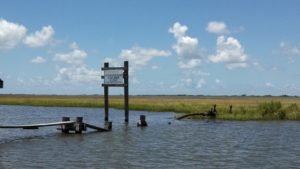
This area was once covered by marsh, but it’s far easier to boat through water than plants, so we’ve cut through the marsh with navigation channels. This increases the amount of marsh exposed to regular wave action and can increase erosion.
I spent the last few days at a conference in New Orleans about the changing Gulf Coast that brought together researchers, engineers, long-time residents, and a wide variety of other people. The point was to share information and viewpoints about what is happening along the coast over the short- and long-term. Sea-level rise and climate change are concerns, development is a concern, fisheries are a concern, etc. And something that was mentioned on a regular basis was the loss of wetlands as water levels go up, land compacts downward, and areas get broken up into smaller and smaller fragments. This is something I have seen myself during several years of research in coastal Louisiana- spaces that are land on a map show a mosaic of land and water when you drive by, grassy islands in interior bays get smaller with every storm.
I know that wetland loss is a major issue in Louisiana and elsewhere, but I’m not sure about all of the details. Where I work, the combined forces of rising seas and subsiding land are the main factors, but I don’t know how representative that pattern is of other locations. I’ve heard that wetland loss in Louisiana is a big deal because Louisiana contains such a large portion of the wetlands in the US, but surely there are other areas we should be paying attention to as well. And I’m really curious about what can be done to slow or even reverse wetland loss in different situations- I’ve heard a lot about sediment deposition and the idea that confining the Mississippi between levees to prevent floods has deprived the surrounding wetlands of the sediment they need to keep their heads above water, but does that mean that our only option is to ‘free’ the rivers, because that could be a hard sell in some communities. And some wetlands aren’t connected to river deltas, so what’s going on there?
So following all of the discussions and ideas about coastal ecology that I’ve heard this week, I’m going to focus on wetland loss and conservation in my blog this month. Let’s see what the state of the world’s wetlands is.

River otter in Lake Woodruff NWR- photo by Andrea Westmoreland. License
I spent some time this week looking into ways to get involved in otter conservation, and I’ve found a number of activities which run the gamut from pressing a few buttons on your computer to spending some time hanging out in a stream. I’ve divided them up into several categories- hopefully you find something that is appealing!
You can help otters from the comfort of your desk by donating to the following organizations:
Practices in your own backyards can have an impact on river otters-
If you see a river otter, there are some people who would appreciate hearing about it:
You can volunteer to help with river restoration projects that benefit otters such as:
Or you can volunteer directly with otter researchers or rehabbers:
And remember that a large number of the options listed here involve local and regional groups, so you may find other opportunities close to you if you do a little searching. So see what you can find, and see if you can find a few river otters near you- they are great fun to watch!
In my last post, I mentioned that habitat degradation and human-caused mortality were some of the biggest issues facing river otters. Recent research has tended to support those views, while providing more detail about where, how, and when those issues loom largest. We’ve also seen that otter populations can recover with protection, but there are no over-night successes.

Asian short-clawed otter- photo by Dulup. License
Degraded waterways are a big deal for otters– and they tend to like forested areas along water bodies, as I mentioned before. Some research from Argentina suggests that neotropical river otters are willing to use areas set aside for forestry (Gomez et al. 2014), so there appear to be ways that we can share these riparian forests with otters. But it takes more than a few good trees to make good habitat for river otters- vegetation within the river itself is important. Rivers that are canalized and/or dredged have little to no vegetation along their bottoms either because they are sealed by concrete or regularly scoured to ensure vessels can pass- this results in a different fish community than rivers with natural beds. In the case of European otters in Poland, not only did the fish community in canal systems contain poorer food resources for otters, but the otters started eating more amphibians which aren’t as energetically rewarding as fish (Kloskowski et al. 2013). And naturally-occurring water bodies seem to be preferred by river otters in North America- reservoirs created by beavers were utilized more often than man-made reservoirs in Massachusetts (Newman and Griffin 1994).
We do know that otter populations can increase with protection, which is great, but it’s clear that it is not a fast process and there are limits to what can be accomplished. Researchers surveying for giant river otters in Brazil found that, although protected by national and international legislation, populations were experiencing slow population growth at best (dos Santos Lima et al. 2013). When a population increases in size, it can only take the species so far- at a certain point there isn’t enough space or food or some other resource. Once a studied population in Finland got to a certain density, litter size decreased, so that, even with more otters reproducing, the population was not growing as quickly (Sulkava et al. 2007). Those animals which moved into unoccupied areas to get away from the crowding faced challenges of their own since not all habitat is equal- during harder winters in Finland, very few otters survived when they weren’t in prime habitat.
So it’s a matter of preserving habitat, and enough of it, plus making sure that adequate fish resources are available. Plus we have to deal with both vehicle-caused mortality- in the Czech Republic this was responsible for more than 75% of recorded otter deaths in between 1990 and 2011 (Polednik et al. 2011) – and intentional killing, for example as a result of competition for fish between otters and fishermen (Kafle 2009). Why should we make the effort? Well, in addition to the role of otters as sentinel species whose presence or absence can let us know when our waterways are in trouble, there is some suggestion that otters may help limit smaller carnivores, such as mink, which can be a good thing in places where mink are threatening the survival of smaller animals, like water voles (McDonald et al. 2007).
How can we help river otters continue to do their thing? In my next post, I hope to have some good answers for that question!
Works cited:
Gomez, J. J., J. I. Túnez, N. Fracassi, and M. H. Cassini. 2014. Habitat suitability and anthropogenic correlates of Neotropical river otter (Lontra longicaudis) distribution. Journal of Mammalogy 95:824–833.
Kafle, G. 2009. A Review on Research and Conservation of Otters in Nepal. IUCN Otter Specialist Group Bulletin 26:32–43.
Kloskowski, J., J. Rechulicz, and B. Jarzynowa. 2013. Resource availability and use by Eurasian otters Lutra lutra in a heavily modified river-canal system. Wildlife Biology 19:439–451.
McDonald, R. A., K. O’Hara, and D. J. Morrish. 2007. Decline of invasive alien mink (Mustela vison) is concurrent with recovery of native otters (Lutra lutra). Diversity and Distributions 13:92–98.
Newman, D. G., and C. R. Griffin. 1994. Wetland Use by River Otters in Massachusetts. The Journal of Wildlife Management 58:18–23.
Polednik, L., K. Polednikova, J. Vetrovcova, V. Hlavac, and V. Beran. 2011. Causes of deaths of Lutra lutra in the Czech Republic (Carnivora: Mustelidae). Lynx 42:145–157.
dos Santos Lima, D., M. Marmontel, and E. Bernard. 2013. Reoccupation of historical areas by the endangered giant river otter Pteronura brasiliensis (Carnivora: Mustelidae) in Central Amazonia, Brazil. Mammalia 78:177–184.
Sulkava, R. T., P. O. Sulkava, and P. E. Sulkava. 2007. Source and sink dynamics of density-dependent otter (Lutra lutra) populations in rivers of central Finland. Oecologia 153:579–588.










